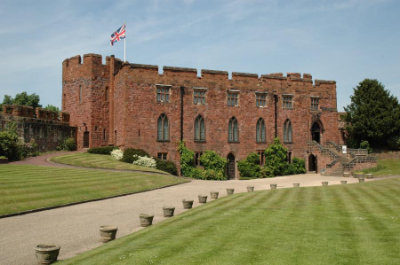Castle Studies Trust award grant for archaeology project at Shrewsbury Castle
The Castle Studies Trust (CST) has awarded a grant of £9,500 for an archaeology project at Shrewsbury Castle.

Grade I listed Shrewsbury Castle
The work is being directed by local archaeologist Dr Nigel Baker and is being supported by Shropshire Council and University Centre Shrewsbury.
The main aim of the project at Shrewsbury Castle is gain a better understanding of the planning, scale of investment and dating of the buildings that were once in the inner bailey.
The project will also look to help us understand the form of the earliest castle and the landscape that it was built upon.
A geophysical survey of the inner bailey of the castle will be undertaken and a small excavation on the grass area in front of the main entrance to the Regimental Museum will be carried out.
The geophysical survey will take place on Thursday 9 May 2019.
The excavation is expected to be carried out in late July 2019 and there will be opportunities for members of the public to visit and ask questions.
Dr Nigel Baker, said:
“The geophysical survey is the first stage of a project funded by the Castle Studies Trust to find out more about Shrewsbury Castle. Despite being an almost perfectly-preserved Norman motte-and-bailey castle, it has never before been excavated.
Coincidentally, 2019 marks the 950th anniversary of the castle’s first appearance in the history books, when it resisted a siege during a local rebellion against Norman rule led by Edric the Wild.”
Lezley Picton, Shropshire Council Cabinet member for culture and leisure, said:
“This grant is wonderful news for Shrewsbury Castle. In Shrewsbury, we are incredibly lucky to have one of the best preserved medieval earthwork castles in England, but also one of the least well known.
“This project will help us raise greater awareness of this truly beautiful castle so Shropshire residents and visitors can fully enjoy its splendour.”
Dr Andy Wigley, natural and historic environment manager at Shropshire Council, said:
“This is an excellent opportunity to increase our understanding of one of Shropshire’s most important castles, and at same time to raise public awareness of the site. The CST grant will wholly fund the work and we also intend to use the information the project will provide to inform how the Council manages the site in the future.”
Shrewsbury Castle is owned by Shropshire Council.
Shrewsbury Castle is open from 10.30am to 4pm every day except Thursday and Sunday and the grounds are free to visit.
For more information about Shrewsbury Castle, click here.
Further Information
Castle Studies Trust
The Castle Studies Trust is a UK based charity founded in July 2012 with the aim of increasing knowledge of castles in the UK and abroad. The Trust has the express aim of:
‘The advancement of public education for public benefit by promoting the study of and research into the history and archaeology of castles and dissemination of all useful results of such research.’
The CST focuses on funding new pieces of research such as site based research as well as projects that increase the public understanding of these sites.
The CSTis entirely funded by the public so we rely on donations to fund our grants. The CST is developing a programme of exclusive site visits for donors to the projects they have helped fund during the research process or soon after, with an opportunity to find out about the results first, prior to publication.
For more information about the CST, click here.
Shrewsbury Castle
Shrewsbury Castle is a Scheduled Ancient Monument (SAM) and is one of the oldest SAMs in the country. It is also a Grade 1 listed building and was first listed by Historic England in 1953.
The Castle is one of the best-preserved, Conquest-period earthwork castles in England, but is also one of the least well-known. No excavation work has taken place within its current perimeter. It is unusually well preserved because it escaped rebuilding.
Shrewsbury Castle is first mentioned by Orderic Vitalis, writing in the early 12th century, who gives an account of its unsuccessful siege in the west Mercian rebellion of 1069. He described it as the praesidium regis, usually translated as ‘royal stronghold’.

